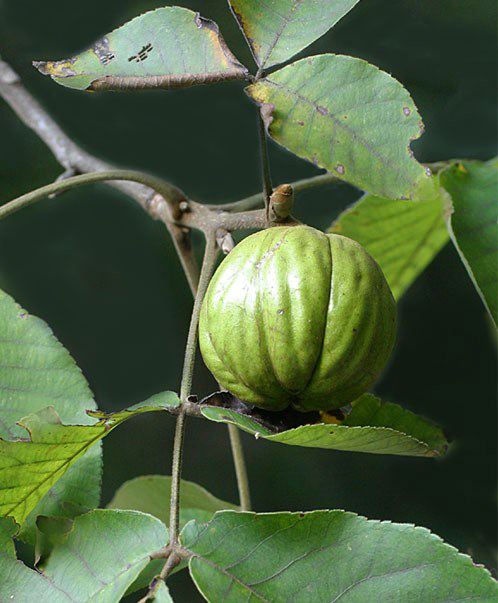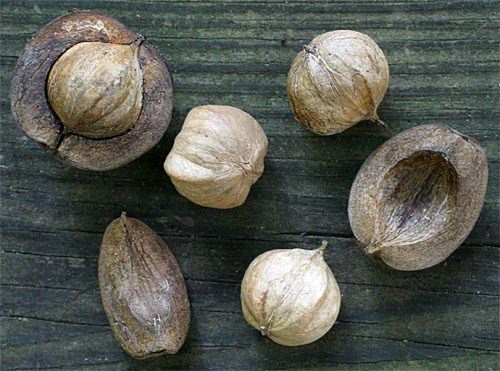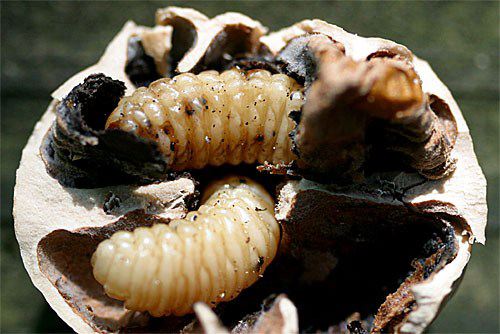|
|
|||
|
|
|||
(Back to Preceding Week; on to Next Week)
|
SHAGGYBARK TREE BLAM! (A minute passes.) BLAM! (Another half-minute or so.) BLAM! That's the frequent but nonetheless startling sound that occurs at Hilton Pond Center each autumn, when squirrels start dropping nuts from a towering Shagbark Hickory tree onto a tin-roofed storage shed less than 50 feet from our computer desk. BLAM! 
All text & photos © Hilton Pond Center It's almost as if Eastern Gray Squirrels can visualize a bullseye on the shed roof and they're having a contest to see which of their bushy-tailed crew can make the greatest noise with the most direct hits. Fortunately, the metal roof of the office itself isn't directly beneath the hickory's limbs, BLAM! The outbuilding makes a pretty good target, and the big, round hickory nuts are especially good bombs. Actually, the squirrels aren't lobbing just the nut, but it AND a thick green husk that surrounds and protects the fruit as it ripens (top photo). These spheres are pretty substantial--two inches in diameter and, based on several we checked with an electronic balance, weighing in at almost two ounces--about the same size and heft as a Grade A Large chicken egg. (We can at least be relieved the squirrels have no access to laying hens.) BLAM! Shagbark Hickories are well-named. Their gray bark--very smooth in young saplings--begins forming fissures when the trunk gets past about 4" in diameter, and in older individuals the bark begins exfoliating in random patterns (left). Each long, thick bark plate is attached at the middle, with both ends curving away from the trunk and giving the tree a truly shaggy appearance. The Shagbark's scientific epithet, Carya ovata, comes from the Greek word for the walnut tree (hickories are in the Walnut Family, the Juglandaceae) and from the ovoid shape of the fruit. "Hickory" is derived from pawcohiccora, an Algonquin Indian word for the tree's oily nutmeat. BLAM!  Removing the husk from a Shagbark nut before its time is hard work. Nearly all the fruits that bounce off the shed roof show gnaw marks from squirrels, but even with razor-sharp incisors these arboreal rodents have a tough time getting through the dense green matter. Left to ripen without being molested by squirrels, the husk turns brown, becomes woody, and--when the fruit finally falls to the ground--shatters open in four parts to reveal the nut within (above). BLAM! The tan-colored nutshell is quite thick and just as impervious to intruders as the husk. In addition to the aforementioned Eastern Gray Squirrels that eat Shagbark nuts at treetop heights, other wildlife dines on the fruit after it hits the ground. Eastern Chipmunks are adept at chewing open hickory shells, and even diminutive White-footed Mice will work the nut until they finally get inside. Black Bears are known to tank up on Shagbark fruit prior to hibernation, while Wild Turkeys swallow and then grind the nuts in their powerful gizzards.
BLAM!
Although we've seen Shagbark Hickories in the Carolina Piedmont east of Hilton Pond and York County, their more common natural range is from the western edge of the Piedmont to the eastern edge of the Great Plains, and north to the Great Lakes and southern New England. Shagbark is less abundant than some other southern hickories and grows primarily in well-drained soil in valleys and on slopes to altitudes of about 2,000 feet. It's worth noting that there may be another Shagbark in the Piedmont. Some dendrologists consider the Carolina Shagbark Hickory, Carya carolinae-septentrionalis, to be a separate species, while others lump it as a variety of C. ovata. The Carolina Shagbark's new twigs are thin and black--those of C. ovata are grayish-tan and thicker--and it may grow on drier, more alkaline soils; its nuts are supposedly smaller and leaflets narrower. DNA work is probably needed to determine whether the two types are distinct Shagbark species. The big Shagbark Hickory at Hilton Pond Center is, to our eyes, a quite handsome tree, tall and straight for the first 50 feet or so and then tilting slightly southward where its branches mingle and compete with those of a huge Southern Red Oak. We've watched the Shagbark grow, albeit slowly, over the 21 years we've lived at the Center, until now it stands about 75 feet and has a trunk more than five feet in circumference and 21" in diameter--very respectable dimensions for a Shagbark Hickory. In defense of squirrels that toss hickory nuts at our shed, we should mention that several kinds of insects can infest and abort the fruit, causing it to fall prematurely. These include Hickory Shuckworms (Laspeyresia caryana), Pecan Weevils (Curculio caryae), and Hickorynut Curculio Weevils (Conotrachelus affinis and C. hicoriae). In fact, as we cracked open nut after nut to find just one with photographable nutmeat, we encountered a shell that was "empty"--except for three fat half-inch beetle grubs that consumed the contents and had grown to fill the one-inch nut (below). Tree experts calculate that up to 85% of hickory nuts may be infested by insects in bad years, so it's no wonder we see few Shagbark Hickory seedlings springing up beneath our majestic big tree at Hilton Pond Center.  Regardless of whether insects or squirrels are responsible for premature fruitfall from the Center's towering Shagbark Hickory, at this time of year we're inclined to wear a hard hat whenever we go outside. It's a wise safety precaution--just in case the bombardiers are off-target as they toss hickory nuts from our shaggybark tree toward the metal roof of the nearby shed. BLAM! BLAM! Flower photos © Paul Wray, Iowa State University, www.forestryimages.org Comments or questions about this week's installment? NOTE: Be sure to scroll down for an account of all birds banded or recaptured during the week, as well as some other interesting nature notes. "This Week at Hilton Pond" is written & photographed You may wish to consult our Index of all nature topics covered since February 2000. You can also use the on-line Search Engine at the bottom of this page. For a free, non-fattening, on-line subscription to "This Week at Hilton Pond," just send us an E-mail with SUBSCRIBE in the Subject line. Please be sure to configure your spam filter to accept E-mails from hiltonpond.org. |
If you enjoy "This Week at Hilton Pond," please help support Hilton Pond Center for Piedmont Natural History. It's painless, and YOU can make a difference! (Just CLICK on a logo below or send a check if you like; see Support for address.) |
|
Make credit card donations on-line via Network for Good: |
|
Use your PayPal account to make direct donations: |
|
If you like shopping on-line please become a member of iGive, through which 1,200+ on-line stores from Amazon to Lands' End and even iTunes donate a percentage of your purchase price to support Hilton Pond Center.  Every new member who registers with iGive and makes a purchase through them earns an ADDITIONAL $5 for the Center. You can even do Web searches through iGive and earn a penny per search--sometimes TWO--for the cause! Please enroll by going to the iGive Web site. It's a painless, important way for YOU to support our on-going work in conservation, education, and research. Add the iGive Toolbar to your browser and register Operation RubyThroat as your preferred charity to make it even easier to help Hilton Pond Center when you shop. Every new member who registers with iGive and makes a purchase through them earns an ADDITIONAL $5 for the Center. You can even do Web searches through iGive and earn a penny per search--sometimes TWO--for the cause! Please enroll by going to the iGive Web site. It's a painless, important way for YOU to support our on-going work in conservation, education, and research. Add the iGive Toolbar to your browser and register Operation RubyThroat as your preferred charity to make it even easier to help Hilton Pond Center when you shop. |
|
|
|
|
SPECIES BANDED THIS WEEK: * = New species for 2003 WEEKLY BANDING TOTAL 13 species 35 individuals
YEARLY BANDING TOTAL (2003) 50 species 860 individuals
BANDING GRAND TOTAL (since 28 June 1982) 123 species 42,974 individuals |
Chestnut-sided Warbler
NOTABLE RECAPTURES THIS WEEK (with original banding date, sex, and current age) American Goldfinch (1) 04/23/01--4th year male Tufted Titmouse (1)
VAGRANT HUMMINGBIRDS None this week
OTHER SIGHTINGS OF INTEREST --This week was by far the most productive of the year for Ruby- throated Hummingbirds, with 18 banded at Hilton Pond Center-- including a rather late adult male on 10 Sep. Despite this influx, we've resigned ourselves that 2003 will be one of our poorest hummingbird years since the hummer study began at the Center in 1984. |
Back to Preceding Week; on to Next Week
|
|
|
Up to Top of Page Current Weather Conditions at Hilton Pond Center |
 You can also post questions for The Piedmont Naturalist |
Join the |
Search Engine for |
|
|
Walmart Discount Coupons
The link above is required by a Web site that provides us with a free page counter.
You are not obligated to click on the link.